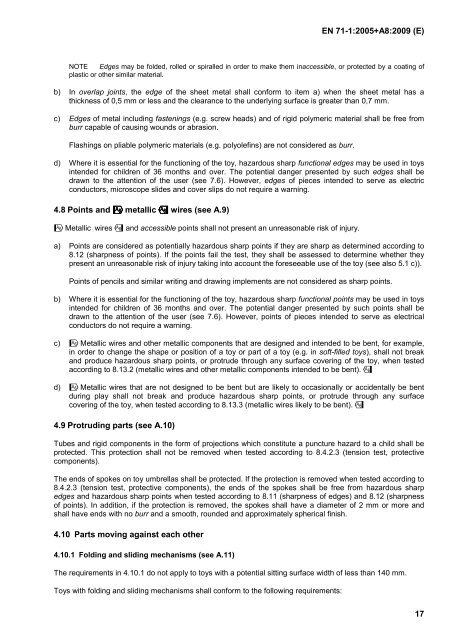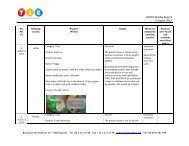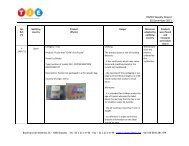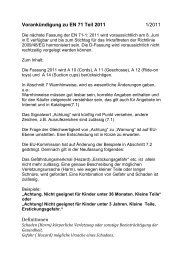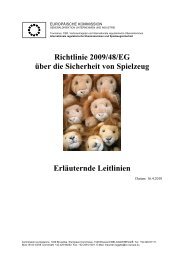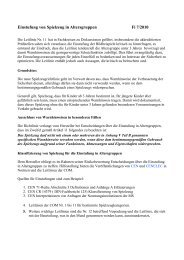Create successful ePaper yourself
Turn your PDF publications into a flip-book with our unique Google optimized e-Paper software.
<strong>EN</strong> <strong>71</strong>-1:<strong>2005+</strong><strong>A8</strong>:2009 (E)<br />
NOTE Edges may be folded, rolled or spiralled in order to make them inaccessible, or protected by a coating of<br />
plastic or other similar material.<br />
b) In overlap joints, the edge of the sheet metal shall conform to item a) when the sheet metal has a<br />
thickness of 0,5 mm or less and the clearance to the underlying surface is greater than 0,7 mm.<br />
c) Edges of metal including fastenings (e.g. screw heads) and of rigid polymeric material shall be free from<br />
burr capable of causing wounds or abrasion.<br />
Flashings on pliable polymeric materials (e.g. polyolefins) are not considered as burr.<br />
d) Where it is essential for the functioning of the toy, hazardous sharp functional edges may be used in toys<br />
intended for children of 36 months and over. The potential danger presented by such edges shall be<br />
drawn to the attention of the user (see 7.6). However, edges of pieces intended to serve as electric<br />
conductors, microscope slides and cover slips do not require a warning.<br />
4.8 Points and +metallic, wires (see A.9)<br />
+Metallic wires, and accessible points shall not present an unreasonable risk of injury.<br />
a) Points are considered as potentially hazardous sharp points if they are sharp as determined according to<br />
8.12 (sharpness of points). If the points fail the test, they shall be assessed to determine whether they<br />
present an unreasonable risk of injury taking into account the foreseeable use of the toy (see also 5.1 c)).<br />
Points of pencils and similar writing and drawing implements are not considered as sharp points.<br />
b) Where it is essential for the functioning of the toy, hazardous sharp functional points may be used in toys<br />
intended for children of 36 months and over. The potential danger presented by such points shall be<br />
drawn to the attention of the user (see 7.6). However, points of pieces intended to serve as electrical<br />
conductors do not require a warning.<br />
c) +Metallic wires and other metallic components that are designed and intended to be bent, for example,<br />
in order to change the shape or position of a toy or part of a toy (e.g. in soft-filled toys), shall not break<br />
and produce hazardous sharp points, or protrude through any surface covering of the toy, when tested<br />
according to 8.13.2 (metallic wires and other metallic components intended to be bent).,<br />
d) +Metallic wires that are not designed to be bent but are likely to occasionally or accidentally be bent<br />
during play shall not break and produce hazardous sharp points, or protrude through any surface<br />
covering of the toy, when tested according to 8.13.3 (metallic wires likely to be bent).,<br />
4.9 Protruding parts (see A.10)<br />
Tubes and rigid components in the form of projections which constitute a puncture hazard to a child shall be<br />
protected. This protection shall not be removed when tested according to 8.4.2.3 (tension test, protective<br />
components).<br />
The ends of spokes on toy umbrellas shall be protected. If the protection is removed when tested according to<br />
8.4.2.3 (tension test, protective components), the ends of the spokes shall be free from hazardous sharp<br />
edges and hazardous sharp points when tested according to 8.11 (sharpness of edges) and 8.12 (sharpness<br />
of points). In addition, if the protection is removed, the spokes shall have a diameter of 2 mm or more and<br />
shall have ends with no burr and a smooth, rounded and approximately spherical finish.<br />
4.10 Parts moving against each other<br />
4.10.1 Folding and sliding mechanisms (see A.11)<br />
The requirements in 4.10.1 do not apply to toys with a potential sitting surface width of less than 140 mm.<br />
Toys with folding and sliding mechanisms shall conform to the following requirements:<br />
17


